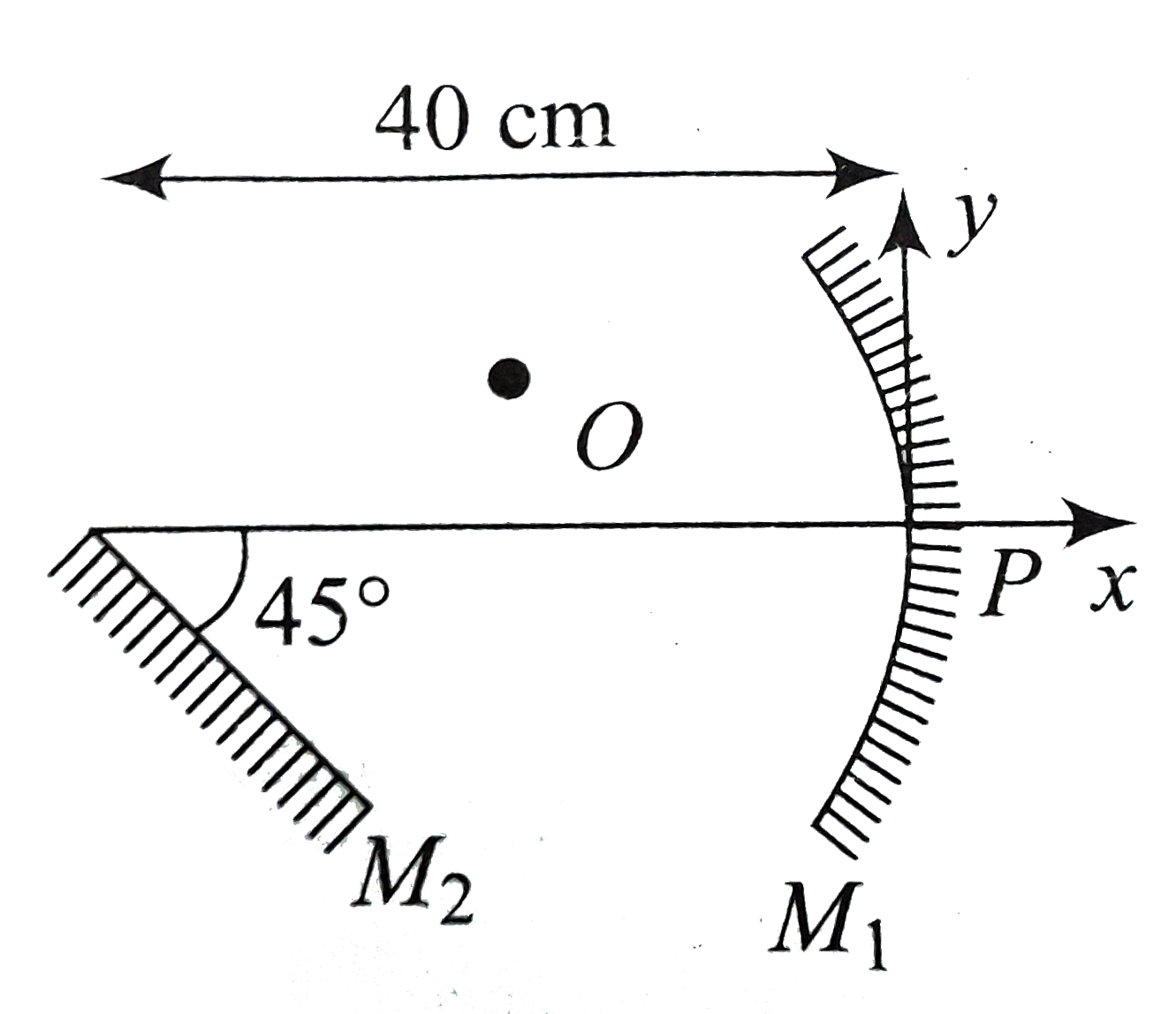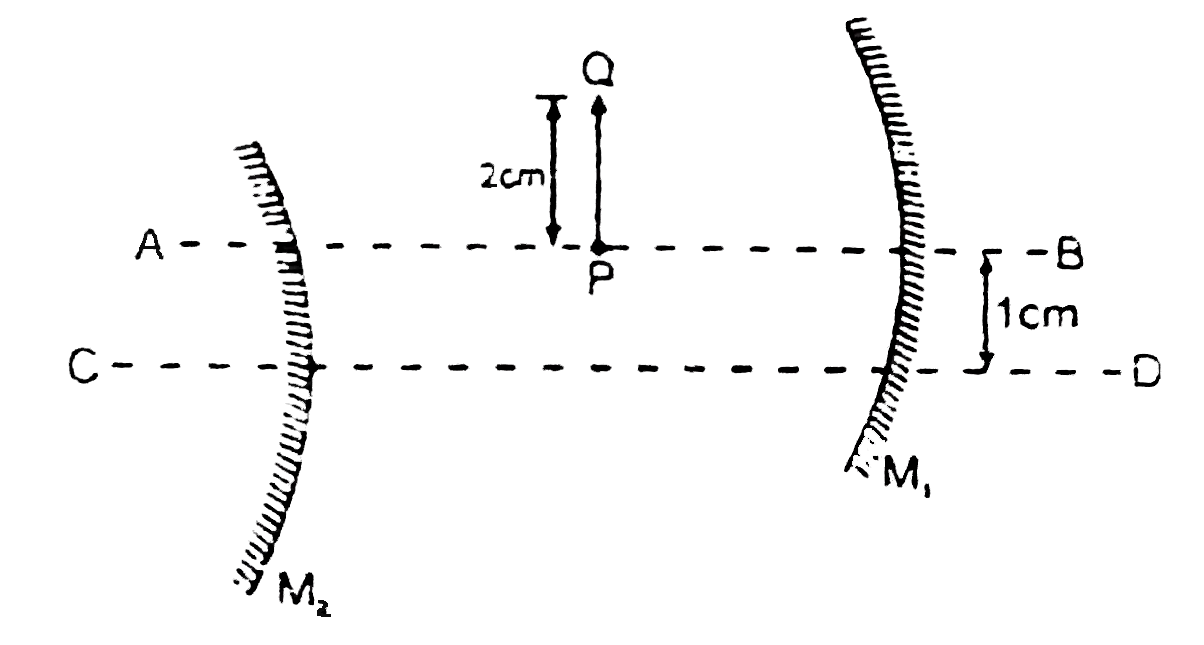Two concave mirrors each of radius of curvature 40cm are placed such that their principla axes are parallel to each other and at a distance of 1cm to each other. Both the mirrors are at a distance of 100cm to each other. Consider first reflection at M1 and then at M2 , find the coordinates of the image thus formed. Take location of object as the origin

The correct Answer is:12 cm , -0.6 cm
_E01_125_S01.png)
f= -20 cm ,1v+1(−60)=1(20)
1v=160−120=−4060×20⇒v=−30
m=−vu=(−30×−1)(−60)=−12
So image coordinates are (-30 , 3/2)
At m2:
1v+1(70)=1−20⇒1v=170−120=−5070×20
v=−1405 = -28 cm
So magnification = −vu=(−28)(−1)(−70)=−25
Object length = 32 cm
image length = (32)(25)=35cm
below axis of M2:y=(−35)
x coordinate = (40−28)=12
so coordinates = (12,−35)
Topper's Solved these Questions
- GEOMETRICAL OPTICSBook:ALLENChapter:GEOMETRICAL OPTICSExercise:EXERCISE-04[B]
Explore 18 Videos
- GEOMETRICAL OPTICSBook:ALLENChapter:GEOMETRICAL OPTICSExercise:EXERCISE-05 (A)
Explore 35 Videos
- GEOMETRICAL OPTICSBook:ALLENChapter:GEOMETRICAL OPTICSExercise:EXERCISE-3
Explore 12 Videos
- CURRENT ELECTRICITYBook:ALLENChapter:CURRENT ELECTRICITYExercise:All Questions
Explore 427 Videos
- GRAVITATIONBook:ALLENChapter:GRAVITATIONExercise:EXERCISE 4
Explore 9 Videos
Similar Questions
A concave mirror having a radius of curvature 40 cm is placed in front of an illuminated point source at a distance of 30 cm from it. Find the location of the image.
View SolutionTwo plane mirrors X and Y are placed parallel to each other and are separated by a distance of 20 cm. An object is placed between the two mirrors at a distance 5 cm from the mirror X. Find the distance of the first three image formed in the mirror X.
View Solution
Knowledge Check
When an object is placed between two parallel mirrors, then number of images formed are
A2BinfiniteC3D4Image formed by a concave mirror radius of curvature 40 cm is half the size of the object. Then distance of object and its image from the mirror will be -
A30cm and 60cmB60cm and 120cmC60cm and 30cmD120cm and 60cmA concave mirror of radius of curvature 40cm forms an image of an object placed on the principal axis at a distance 45 cm in front of it. Now if the system (including object) is completely immersed in water (μ=1.33) , then
Athe image will shift towards the mirrorBthe magnification will reduceCthe image will shift away from the mirror and magnification will increase.Dthe position of the image and magnification will not change.
As shown in Figure,. And object O is at the position (-10,2) with respect to the origin P. The concave mirror M1 has radius of curvature 30cm. A plane mirror M2 is kept at a distance of 40cm in front of the concave mirror. Considering first refletion on the concave mirror M1 and second on the plane mirror M2. Find the coordinates of the second image w.r.t. the origin P.

View SolutionWhen an object is placed between two parallel mirrors, then number of images formed are
View SolutionTwo plane mirrors are placed parallel to each other. The distance between the mirrors is 10cm. An object is placed between the mirrors at a distance of 4cm from one of them, say M1. What is the distance between the first time formed at M1 and the second image formed at M2 ?
View SolutionTwo plane mirrors are placed parallel to each other and 40 cm apart. An a object is placed 10 cm from one mirror .What is the distance from the object to the image for each of the five images that are closest to the object?
View SolutionIn the figure shown M1 and M2 are two spherical mirrors of focal length 20cm each. AB and CD are their principal axes respectively which are separated by 1cm.PQ is an object of height 2cm and kept at distance 20cm from M1. The separation between the mirrors is 50cm Consider two successive reflections first on M1 then on M2. Find the size of the 2nd image. Also find distances of and points P'' and Q'' of that image from the line AB.
 .
.
View Solution
